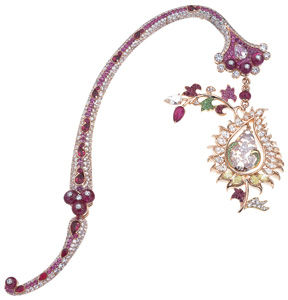 |
Paisley brooch by Prince Dimitri
|
Walking into the offices of Prince Dimitri of Yugoslavia is
like stepping into another world — a world of elegance that leaves the hubbub
of midtown Manhattan far away, a world of history and tradition that underpins
our modern life. Most of all, it is a world of sophisticated jewels.
Stepping off the elevator, one is greeted by showcases
holding bold jewelry in a foyer that has the aura of a miniature replica of a
palace hallway. Once inside, the warm and inviting office is more like a living
room. It is calm and comfortable, with faded celadon walls and an ivory linen
overstuffed couch that is the focal point. At one end of the room is a celadon
shagreen desk, while at the other end is a dining table that doubles as a work
space. Accents of fuchsia pop throughout the area. Large windows along three
walls flood the space with natural light that is perfect for viewing jewelry.
Photographs and objets d’art, along with built-in bookcases filled with tomes
on history and royalty, add to the ambience.
Becoming a jewelry designer “happened by mistake,” says
Dimitri, who was a senior vice president at Sotheby’s for many years. “I was in
Miami in 1998 and a friend of mine had bought some stones and had them made
into cufflinks. They were very badly made. I had this idea to drill the stones,
so there would be no prongs. That way, the stones really showed and there was
just a dot of gold in the middle. That idea developed into stones with another
small gem in the center.”
Friends
It was the power of his friends that launched Dimitri to the
next level. They saw the cufflinks he had designed and wanted them as well. So,
around Christmastime, one of his friends hosted a cocktail party to introduce
the cufflinks to a larger audience. By the end of the evening, all the
cufflinks were sold. Soon after, Dimitri’s cufflinks were selling in the
Bergdorf Goodman men’s shop. “That morphed into a collection of women’s jewelry
with no prongs that was sold at Barney’s, Neiman Marcus and Saks,” explains
Dimitri.
It wasn’t long before Assael, one of the industry’s most
prominent pearl dealers, came knocking on Dimitri’s door. Renowned for his
South Sea pearl strands, Assael wanted to move beyond the classic look and he
asked Dimitri to design for his company. “I love pearls. There is nothing more
feminine,” says Dimitri, who combined the gems with wood, rubber and colored
gemstones, turning the pearls into jewelry coveted by his jet-setting friends
and clients.
During that time, Dimitri met his current business partner
and backer, Todd Morley, who created the hedge funds Guggenheim Partners and
G2. This gave Dimitri the opportunity to launch his design business. “I didn’t
know I had it in me. It just came out of my ability to arrange color and
shapes,” marvels Dimitri.
History
A self-professed history buff, Dimitri gains much of the
inspiration for his designs from the art of previous eras. “I read history all
the time. My work is inspired mostly by the decorative arts, the Renaissance,
Middle Ages, Greek and Roman antiquity, Indian art, the geometry of Islamic art
and the bold look of Russian jewelry, shapes on fabric and the trees at
Versailles,” comments Dimitri, who, when he traces his own heritage back, is
related to almost every royal family in Europe. As for other jewelry designers,
Dimitri has a strong admiration for Boivin. “He was so modern, avant-garde,
light years ahead of his time. I also really admire Bolin, the court jeweler to
the Romanovs. He did my great, great grand-mother’s tiara, which now belongs to
Queen Elizabeth,” he says.
Dimitri segues into a chat about tiaras. He is currently
designing collections for Swarovski and one of his projects has been to create
a tiara for the annual debutante ball in Vienna, where young women in white
dresses dance the minuet. The sketches that he pulls out are magical creations,
with snowflake crystals that dangle delicately on the tiaras. “I did three
sketches, but they could only use one. All the girls have to have the same
tiara so they don’t argue over who gets which one,” he explains. The chosen
tiara is sure to delight any young woman, debutante or not.
One of the signatures of Dimitri’s work is his bold use of
color. “I like all gemstones. I don’t have a favorite, I like color
combinations — emerald with sapphire, pearls with moonstone. It depends on my
mood. I’m a typical Gemini — sometimes, I like red and sometimes, I like green.
It is always changing.”
Movement is also important to Dimitri, who likes to use less
conventional materials in his creations, including steel, bronze, rubber or
leather mixed with precious metals and gems. Paisley is a shape that Dimitri
uses frequently in his jewelry designs. “It’s a very chic shape. In the
nineteenth century, French women wore cashmere shawls from India with paisley
patterns. Paisley originally comes from Greece, where it was an ancient symbol
for a mango, which represents fertility. Then the Indians adopted it. It’s a
happy shape.”
Dimitri himself has a warm wit, the impeccable manners one
would expect from a prince and a certain joie de vivre that is captured in his
jewelry. The pieces that he creates are for a woman whom he describes as “one
who has everything, has seen everything, has a big heart, is very pretty and is
modern with traditional values.”
Article from the Rapaport Magazine - January 2012. To subscribe click here.